John Wayne's Hollywood
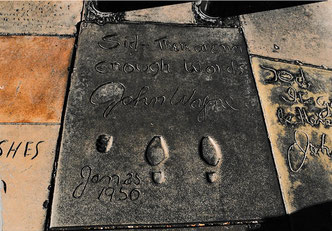
Grauman’s Chinese Theater, 6925 Hollywood Blvd, opened in 1927 and is now the TCL Chinese Theater. Twenty years after the premiere of his first film, The Big Trail, at this movie house, John Wayne joined the ranks of immortal movie legends. He was the 125th star to be immortalized outside the theater.
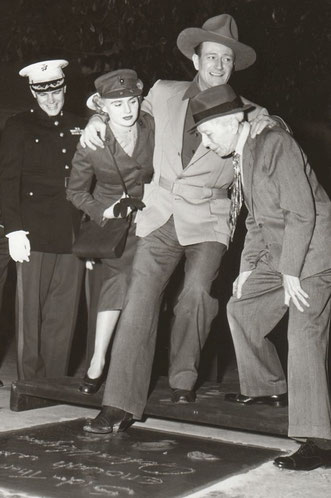
On January 25, 1950, John Wayne put his cowboy boots in the wet cement and etched his name next to it. With the sentiment, „To Sid – there are not enough words“, Wayne paid his respects to the man who had created this Hollywood landmark, Sid Grauman (right). Atypically, this honoree star did not push his hands but his right fist into the cement.
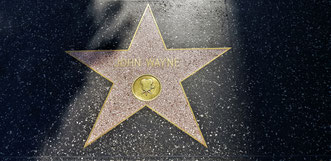
John Wayne's star on the Walk of Fame is on 1541 Vine Street. Not too far from what is now the Ricardo Montalban Theatre on 1615 Vine Street. However, until 1955 this was the CBS Playhouse Theatre where John Wayne performed several times in the radio adaptions of his films. Lux presents Hollywood was a popular anthology show, performed in front of a live audience.
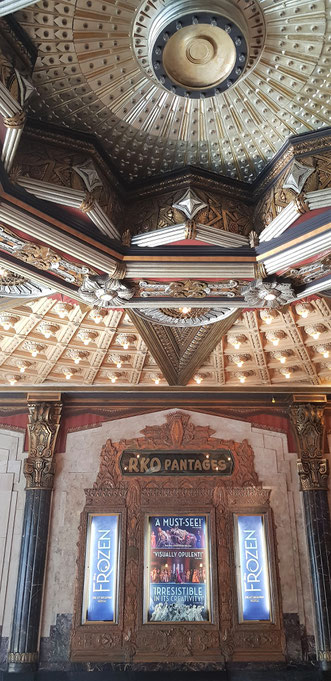
The Hollywood Pantages Theatre, the palatial Art Deco Theater at 6233 Hollywood Blvd, was known as RKO Pantages theatre in the Golden Days of Hollywood when this was the place of the Academy Awards ceremony - and the original name stuck. The first time John Wayne was up for the Academy Award was on March 23, 1950, for Sands of Iwo Jima. He picked up two Oscars on March 19, 1953, at the Pantages – one for John Ford’s direction of The Quiet Man and „one for our beloved Gary Cooper“.

Originally built in 1924 as a health club, the Hollywood Athletic Club was more like a hideout of male stars during the 20s through the 50s. The restored structure of one of Tinseltown‘s most historical buildings still contains the Olympic sized pool. John Ford often spent his afternoons naked in the steam room. John Wayne joined is his early years of stardom, when producers didn't hire him for his acting, "but for how agile you were!"

Pictured here is the original logo of the Hollywood Athletic Club, the famous landmark on 6525 Sunset Boulevard. John Ford's drinking buddies, young John Wayne and Ward Bond among them, formed an inner social club, the „Young Men’s Purity, Total Abstinence, and Snooker Pool Association“, renamed in 1938 as „The Emerald Bay Yacht Club“. They even held their meetings in the steam room.
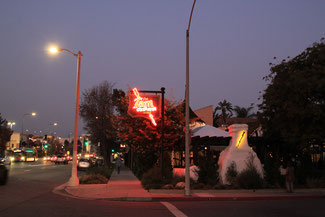
John Wayne was a regular at the Tam O'Shanter Inn even before he was John Wayne. When he was in his sophomore year of Glendale High, he used to bring his first steady girlfriend, Polly Richmond, to the Tam O’Shanter. In later years, his table was always #15. The restaurant at 2980 Los Felix Blvd was favored by nearby Disney Studio employees as Walt's first studio was just across the street.

John Wayne often worked at the Samuel Goldwyn Studios, located at 1041 N Formosa Ave (for the first time when he did the process shots inside a mock-up of the Stagecoach, using rear projection; he also used the facilities to do the postproduction of The Alamo). The studio lot on the corner of Formosa and Santa Monica Blvd had changed hands several times and was leased by different independent producers. Warner Brothers sold it again in 1999 when the name was officially changed to its longtime unofficial nickname, The Lot. However, unchangable is the legendary Hollywood hangout across the street...
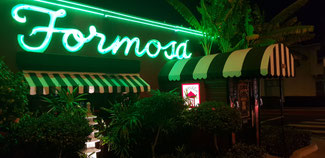
...the Formosa Cafe at 7156 Santa Monica Blvd: According to a Formosa legend (printed on the menu card), John Wayne passed out in his booth after a night of imbiding at the Café. The staff was not able to wake him up and simply locked up. In the morning, they caught him in the kitchen making scrambled eggs. The story inspired the Duke’s All Nighter cocktail.

Chasen's, the famous Hollywood eatery, was located at 9039 Beverly Boulevard in Los Angeles. “Through the doors of Beverly Boulevard walked movie stars and moguls, dignitaries and presidents.” In fact, Ronald Reagan met a girl named Nancy in one of the booths on a blind date. Chasen’s closed in 1995. The original dining room is now a grocery. Nevertheless, the main dining room and the street facade of the original restaurant remain as an eatery and the original look was preserved.

John Wayne became acquainted with RKO owner Howard Hughes over a meal one of these tables at Chasen’s. The billionaire offered to produce movies starring John Wayne (which would eventually lead to Jet Pilot). For many years, the large dining room was the site of the Academy Awards party.

The original entrance to Chasen'sis still visible, although the door was bricked up. Since it opened for business in 1936, it was frequented by entertainers and famous for its chili. While filming Cleopatra in Rome, Elizabeth Taylor had several orders of chili flown to the set. Maureen O’Hara had her own table, dined there at least once a week, and she was there on closing night.

The studios used Bronson Canyon - actually man-made tunnels - countless times. It has the look of a remote setting but it is easily accessible as a section of Griffith Park. So, August 12, 1955, Ethan Edwards took Debbie (Natalie Wood) in his arms at the cave entrance. However, The Searchers was not John Wayne's first trip up there. He had beenfilming in Bronson Canyon 20 years before...
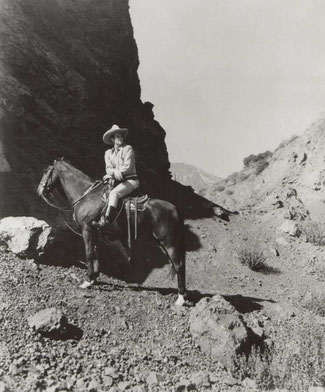
...when he first defended these stark rock faces in the Mascot serial The Hurricane Express. John Wayne rode back into that horseshoe-shaped canyon for Sagebrush Trail in 1933 (pictured here) for an action-packed shootout – he actually drives a stagecoach from one end of the tunnel to the other.

For a long time, John Wayne was one of the owners of the Culver City Hotel at 9400 Culver Blvd, then a few blocks from MGM studios. The “flatiron” changed hands ever since it opened in 1924. It was used as a movie location as early as in the Laurel & Hardy pictures. The six-story Renaissance Revival building is now a national landmark.
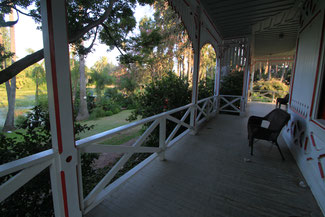
When the State of Californa and the County of L.A. purchased 111 acres of what is known today as the L.A. Arboretum, movie-making history could be made. Because of the large lagoon and the lush foliage surrounding it, this location was often used for jungle type pictures and also for the memorable John Wayne starrer Wake of the Red Witch. Between July and August, 1948, this was the home of the evil owner of the Batjak Shipping Company in Wake of the Red Witch.

As shown in this German movie programm, the Batjak owner supposedly lived in the 1880s Queen Anne Cottage, located in the middle of the parc at Baldwin Lake.

The sea-faring picture Wake of the Red Witch had not been the first time John Wayne filmed at the L.A. Arboretum. His guerilla fighters from Back to Bataan also fought on the Baldwin estate in Arcadia. And some pick-ups for Tycoon were also shot on the premises. The entrance is directly across from the Santa Anita Race Track, at 301 N Baldwin Ave.
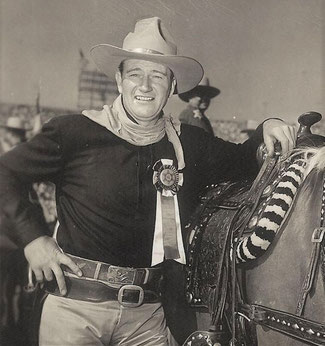
In late 1949, John Wayne accepted the role of Rodeo Grand Marshal at the 5th Annual Sheriff’s Rodeo at the L.A. Coliseum, 3911 Figueroa Street.
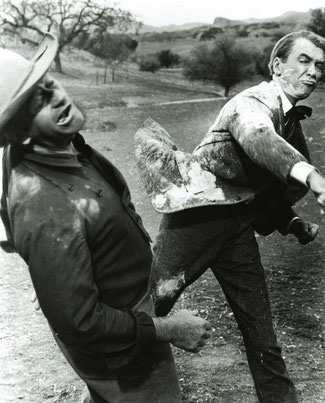
One filming site many location hunters get wrong is the place that Tom Doniphon (John Wayne) called his own spread as The Man who Shot Liberty Valance. Even though it was a Paramount film, it was not filmed on the Paramount Ranch in Agoura. As a matter of fact, the only outdoor sequences (like the one seen here with James Stewart) were shot on the Janss Conejo Ranch. Filmmakers wouldn't even have to cross the cityborders of L.A. That's why TV shows like Bonanza (a Paramount production) used the same wide spread (originally 10,000 acres) regularly.

However, in 1969, the Hawaiian Land Corporation acquired the Janss Conejo ranch land and developed it into the vast city of Thousand Oaks. 1,765 acres were spared, which is now Wildwood Park at 928 W Avenida De Los Arboles, sometimes still used for location shooting. Somewhere in them tar hills lies Tom Doniphon's spread, the location of John Wayne's The Man Who Shot Liberty Valance.

Grauman's Egyptian Theatre is located on Hollywood Boulevard in Los Angeles. California. Several John Wayne movies premiered there in attendence of its stars, including The High and the Mighty. June 19, 1962, a full year after shooting wrapped, Hatari! had its world premiere in the historic movie theatre.

Opened in 1922, The Egyptian is an early example of a lavish movie palace. The same year, entrepreneur Sid Grauman started the tradition of lavish premieres with Robin Hood. As the producer of The Alamo, John Wayne chose the Egyptian Theatre to show hisThe Alamo on October 26, 1960.

The Chateau Marmont at 8221 Sunset Boulevard is one of Hollywood's most legendary hotels. John Wayne occupied the penthouse penthouse apartment in the Sunset Tower in May 1943, when he had finally separated from his 1st wife and needed a place to stay with is 2nd wife to be, Chata. Many legends surround the Spanish castle-like structure. The story that John Wayne kept a pet cow on the balcony is probably exaggerated.

This photo shows the orginal location of the legendary Hollywood night club Cafe Trocadero. Like many other celebrities, John Wayne frequented the French-inspired "Troc", after it immediately became the place where Hollywood stars went to be seen after it openend in 1934, at 8610 Sunset Boulevard, in the posh Sunset Plaza section of the Strip. It closed for good in 1947. In its place stands a mall.

This photo was taken in the place where the original Mocambo Night Club at 8588 Sunset Boulevard stood - now called Sunset Plaza. On any given night, the legendary Hollywood club would be filled with the leading men and women of the picture industry until it closed in 1958. During his rather public fling with Marlene Dietrich, John Wayne went bar-hopping between the South American-styled Mocambo and the Trocadero, which was just a stone's throw away.

The Hollywood Museum shows in its extensive exhibition this wonderful prop jewellery: the necklace that Marlene Dietrich wore alongside John Wayne in Seven Sinners, created by the legendary Joseff of Hollywood.
The building that houses today’s museum on 1660 Highland Ave in Hollywood is the original Max Factor building, owned by the legendary make-up artist to the stars.

John Wayne is one of the stars depicted in this famous Hollywood mural, "Legends of Hollywood" (by Eloy Torrez). It was seen in a scene from La La Land with Ryan Gosling. The painting used to cover the entire western side of a building at the southeast corner of Hollywood Boulevard and Hudson Avenue. Now in bad shape.

John Wayne's plaque on the Main Street in Old Town Newhall. Inductees are honored with bronze stars and terrazzo tiles stamped into Main Street. In the heyday of the western, Newhall was one of the most filmed areas in the Los Angeles area. When Wayne first got to Newhall, he was playing supporting parts to western stars Buck Jones and Tim McCoy.

John Wayne is depicted in this mural on Old Newhall's Main Street, near his plaque on the Walk of Fame. Santa Clarita's rich western movie history is depicted in this mural located near Old Town Newhall's Walk of Western Stars. Similar to the Hollywood Walk of Fame, the Walk of Western Stars honors actors, directors, and other film professionals for their contributions to the Western Heritage in America.
A few years after John Wayne's passing, Great Western Bank decided to honor its advertising spokesperson. Artist Harry Jackson was commissioned with creating the massive 21-foot high bronze “The Horseman”. James Stewart unveiled the 5.4-ton sculpture on July 22, 1984, at Wilshire and La Cienega Boulevards, then called Great Western Savings Plaza. “The Horseman” is facing 8484 Wilshire Bldv. By coincidence, Wilshire was the last address of John Wayne's Batjac office (9570 Wilshire Blvd, Suite 400).
©All text content on this website is protected by copyright and other intellectual property laws. No part may be reproduced without the prior written permission. All photos courtesy of Roland Schaefli, unless otherwise stated.
This website is in no way associated with the John Wayne Estate or business enterprises. Go to johnwayne.com to find the official website and to https://johnwayne.org/ to read about the wonderful John Wayne Cancer Foundation.
more john wayne locations to scout
If you like this site, you'll like the book: the first comprehensive guide to the John Wayne Locations, with hundreds of then-and-now photos, unpublished behind-the-scenes-pictures and detailed tour descriptions
Tracking John Wayne: The complete Tourguide
Find directions to locations and anecdotes from the Duke's movie sets in this new publication from McFarland, available at bookstores and online shops
For all locations mentioned on this website, the book offers behind-the-scenes stories, making-of anecdotes and never before published photos








